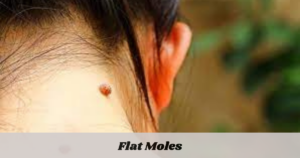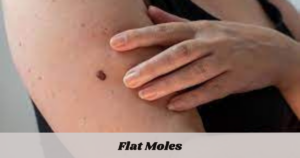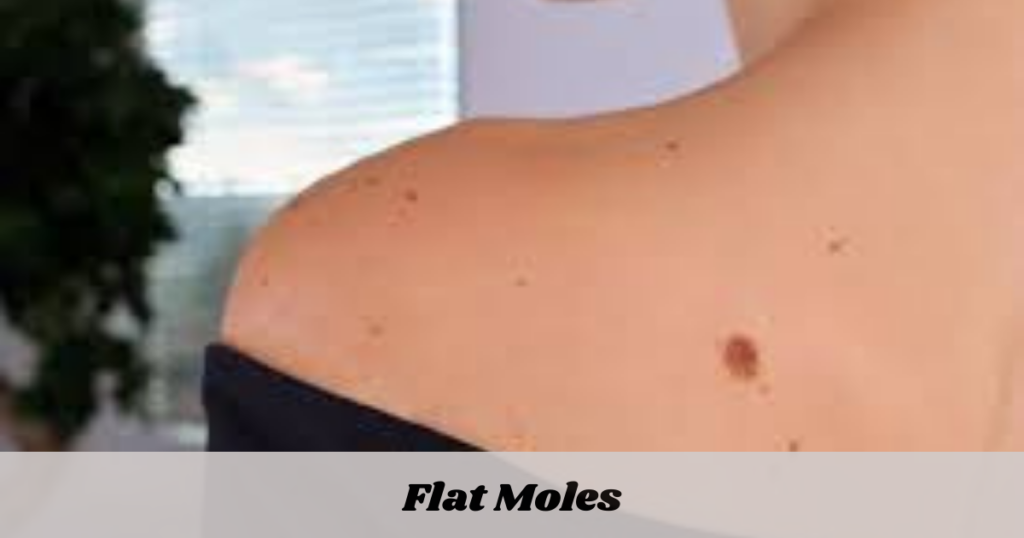Flat moles, also known as melanocytic nevi, are a prevalent skin occurrence that many people encounter. While their presence might raise concerns, the good news is that most flat moles are completely harmless. This guide delves into the details of flat moles, exploring their characteristics, types, potential effects on your skin, and how to effectively manage them.

What Are Flat Moles?
Flat moles are smooth or slightly raised patches of skin with a uniform color. Unlike some other types of moles, they typically lack a noticeable bump or uneven border. They can range in size from a pinhead to a pea and appear anywhere on your body. However, sun-exposed areas like the face, arms, and legs are more prone to developing flat moles. The effects of flat moles on your skin are usually purely cosmetic. They typically don’t cause any pain or discomfort and often blend in seamlessly with your surrounding skin tone.
Types of Flat Moles:
There are two main categories of flat moles, each with slightly different characteristics:
Junctional Nevi:
These flat moles are composed of melanocytes, the pigment-producing cells in your skin. Junctional nevi reside solely in the upper layer of your skin, called the epidermis. They typically appear tan or brown and feel smooth to the touch. Effects of flat moles of this type are minimal, as they lie completely flat on the skin’s surface.
Compound Nevi:
A combination of junctional and dermal nevi, these flat moles contain melanocytes in both the epidermis and the deeper layer of your skin, known as the dermis. This deeper placement can cause compound nevi to appear slightly raised compared to junctional nevi. They may exhibit various colors, including brown, black, or a combination of both. Effects of flat moles of this type can manifest as a slightly raised texture compared to junctional nevi.
Colors of Flat Moles:
Flat moles typically come in a variety of brown hues, ranging from light tan to dark brown. Occasionally, they may appear black or even have a slightly reddish tint. It’s important to note that the color of a flat mole is not necessarily an indicator of its risk. While some may associate darker moles with a higher risk, the color itself doesn’t determine whether a flat mole is benign or not.

Where Do Flat Moles Grow?
Flat moles can appear anywhere on your body. However, they are more likely to develop in areas that receive frequent sun exposure. Here are some common locations for flat moles:
- Face: The face is a prime location for flat moles, particularly the cheeks, forehead, and nose.
- Arms and Legs: Areas of the arms and legs that are regularly exposed to the sun, like the forearms, upper arms, shins, and calves, are common spots for flat moles.
- Back: The back is another area susceptible to flat mole development, especially for individuals who spend a lot of time outdoors without proper sun protection.
- Chest and Abdomen: While less common, flat moles can also appear on the chest and abdomen.
How Do Flat Moles Feel?
As mentioned earlier, flat moles generally feel smooth to the touch. Junctional nevi, due to their location solely in the upper skin layer, tend to feel completely flat. Compound nevi, residing in both the upper and deeper layers, may feel slightly raised above the surrounding skin. They are typically soft and pliable and shouldn’t cause any pain or tenderness. Effects of flat moles in terms of texture are usually limited to this slight elevation for compound nevi.
Living with Flat Moles: Management and Monitoring
Once you understand flat moles and their characteristics, you can effectively manage them and maintain healthy skin. Here are some key tips:
Sun Protection:
Sun exposure is a significant risk factor for skin cancer. Developing a consistent sun protection routine is vital, regardless of whether you have flat moles or not. This includes wearing sunscreen with SPF 30 or higher daily, even on cloudy days. Protective clothing like hats and long sleeves can further shield your skin from harmful UV rays.
Self-Examination:
While the effects of flat moles on your skin are typically minimal, regular self-examination is still crucial. This practice allows you to become familiar with your existing moles and identify any changes that may occur. Perform monthly self-examinations using a mirror in a well-lit area. Pay close attention to areas like your back, scalp, and the soles of your feet, which may be harder to see on your own. Consider having a partner help you examine hard-to-reach areas.
Dermatologist Visits:
Schedule regular checkups with your dermatologist. The frequency may vary depending on your risk factors and skin health, but consulting a dermatologist allows for a professional evaluation of your skin, including any flat moles. During these visits, the dermatologist can address any concerns you may have and provide personalized advice for maintaining healthy skin. Early detection is key for any potential skin issues, and a dermatologist can offer valuable guidance.
Living with Confidence: Embracing Your Skin
Flat moles are a common and natural part of having skin. While some may choose to have them removed for cosmetic reasons, most individuals can live comfortably with flat moles. Here are some tips for embracing your unique skin:
Focus on Overall Skin Health:
Developing a healthy skincare routine that includes gentle cleansing, moisturizing, and proper sun protection is crucial for maintaining a healthy glow. Taking care of your skin as a whole can boost your confidence and minimize the appearance of any flat moles.
Acceptance and Appreciation:
Our skin is a map of our lives, telling stories of sun exposure, laughter lines, and experiences. Learning to appreciate your unique skin features, including flat moles, can contribute to a positive body image.
Seek Professional Help When Needed:
If flat moles cause you significant distress or anxiety, consulting a dermatologist or therapist can be beneficial. They can provide support and guidance in managing your concerns and developing healthy coping mechanisms.
Conclusion:
Understanding flat moles, their characteristics, and how to manage them effectively empowers you to take charge of your skin health. By incorporating sun protection practices, self-examination routines, and regular dermatologist visits into your life, you can maintain healthy skin and address any concerns about flat moles promptly. Remember, most flat moles are harmless, and with proper care, you can live confidently with your unique skin.

